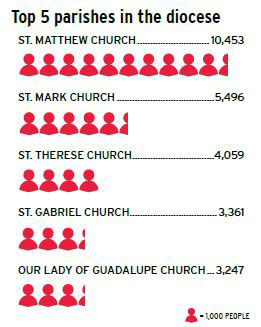 CHARLOTTE — The latest data show that the Diocese of Charlotte has topped 77,000 families, and three of today’s five largest parishes did not even exist when the diocese was formed.
CHARLOTTE — The latest data show that the Diocese of Charlotte has topped 77,000 families, and three of today’s five largest parishes did not even exist when the diocese was formed.
In 1972 when the Charlotte diocese was carved out of the Diocese of Raleigh, there were an estimated 34,208 Catholics at 74 parishes and missions. Today the Charlotte diocese is home to more than 77,445 registered families, a total of at least 220,000 people, in 92 parishes and missions, according to data compiled by the diocesan Development Office and Planning Office.
As of Jan. 1, the five most populous parishes according to diocesan records are: St. Matthew Church in Charlotte (10,453 registered households); St. Mark Church in Huntersville (5,496 registered households); St. Therese Church in Mooresville (4,059 registered households); St. Gabriel Church in Charlotte (3,361 registered households); and Our Lady of Guadalupe Church in Charlotte (3,247 registered households).
St. Matthew, St. Mark and Our Lady of Guadalupe parishes were all created after 1972, the most recent being St. Mark Church in 1997.
St. Matthew Church, established in 1986, is also believed to be the largest Catholic parish in the United States.
“One of the most surprising things I’ve encountered since the beginning of my ministry at St. Matthew is the beautiful ethnic diversity of the population. The increasing number of Latino, Asian, and African members adds a beautiful ‘Catholic’ flavor to our congregation,” says Father Patrick Hoare, pastor of St. Matthew Church. “The size of our parish nearly ensures that a newcomer will find a group of families who share their ethnic heritage. So they can preserve their traditions while still actively participating in the larger community.”
Father Hoare thinks one of his parish’s biggest challenges – like many other churches – is engaging youth and young adults, but the size of his parish is a great help, though.
“Taking advantage of our economies of scale, we can invest in the staffing and high quality programming that is critical in assisting our younger generations to encounter the person of Jesus,” he says.
When St. Therese Church moved to its present site 31 years ago from Main Street in Mooresville, the parish roll totaled 310 families. It now tops 4,000 families.
Father Mark Lawlor, pastor, calls it “an exciting and dynamic time.”
“When I was growing up in Salisbury in the 1970s, Mooresville, Davidson, Cornelius and Huntersville were all small towns,” Father Lawlor recalls. “Like others, I never imagined the development and growth of the past 20 years or so.”
To accommodate the great increase, the parish built a much larger church to accommodate more than 1,000 more people than the former church. It was dedicated nearly four years ago.
“We have recently purchased adjacent property, which I see as an investment for our future,” he says. “We hope to develop the property in the future with the hopes of expanded parking and access to the facilities, areas for youth ministry and recreational activities.”
“While parish facilities are important, parish staff and volunteers are instrumental in making people feel welcome and part of the family,” he adds. “We have expanded our parish staff in the past year and we have more than 1,000 dedicated volunteers serving in numerous ministries.”
One of the most significant changes in the diocese’s recent history has been the rising number of Latino families at nearly every parish. The diocese’s Hispanic ministry started out with humble roots in the late 1980s, later developing a Hispanic Center in Charlotte that has now grown into the diocese’s fifth largest parish: Our Lady of Guadalupe Church
Vincentian Father Gregory Gay, has served as parochial vicar since December 2016, and says his church building is now bursting at the seams.
“In terms of registered parishioners, our numbers fluctuate reflecting the mobility of our Hispanic community. But since I have been here, I have noticed the increase in the number of participants in our Sunday liturgies as well as our weekday Masses,” he says. “Our only hope to respond to the Sunday increase is the expectation of a new church, because presently people are in the hallways and in the lobby attending Mass. For the weekday Masses we have moved the Eucharist from the small chapel to the main multi-purpose room. We also expanded our parking area in order to accommodate more vehicles.”
The parish has renovated the social ministries house to create more space for the parish food pantry and medical services offered there. Father Gay notes that now the space is also more conducive for community meetings such as AA, faith formation for adults and Spanish classes for parishioners.
The Vincentian-run parish has grown from two to three priests, and it has added administrative staff and expanded pastoral office to accommodate the growing congregation.
A positive aspect to all of this growth, Father Gay says, is that the number of participants in their faith formation program has risen.
“We responded to this growth, adding an extra day to the already five-day program,” he says. “The number of adults in faith formation has also increased, so now we have three different groups instead of two, ensuring the possibility that people can complete their sacraments. To accompany the parents of our children in faith formation, we have initiated obligatory classes allowing them to fulfill their baptism commitment to educate their children in the faith.”
— SueAnn Howell, senior reporter


